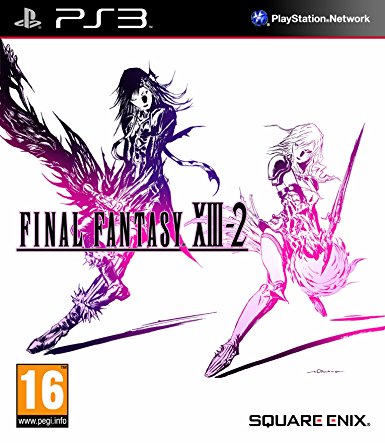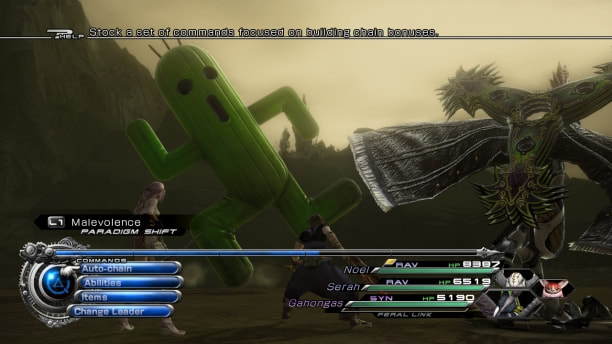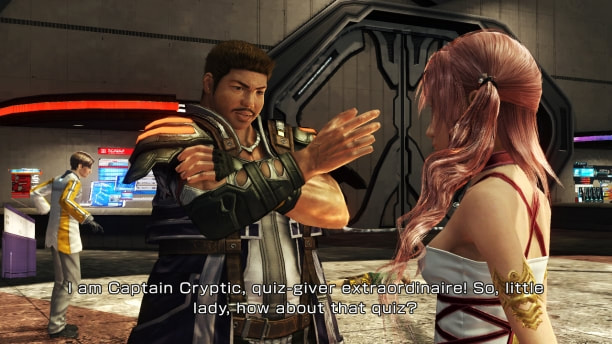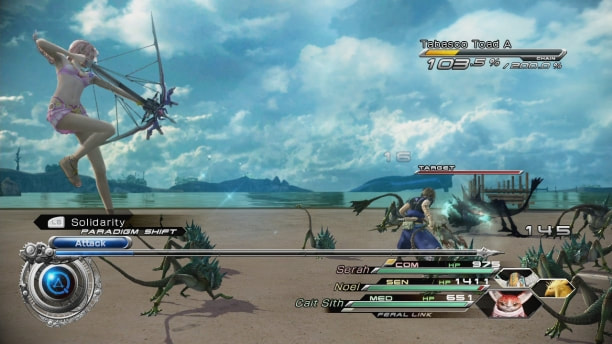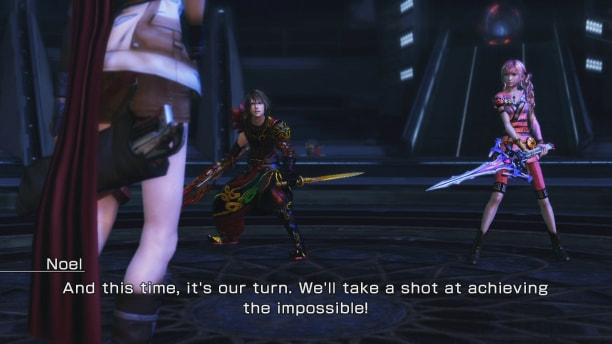FINAL FANTASY XIII-2 (PS3)
Though expectations were high in the run-up to its release, Final Fantasy XIII marked what was likely the nadir of the celebrated role-playing series' more than twenty-year odyssey. An adventure devoid of the freedom or exploration fans had come to expect, it brought into harsh focus a story defined by vapid, unlikeable characters who represented a veritable checklist of cliches. Its listless, am-dram cut-scenes were a chore, and at times, bordered on the embarrassing.
Adopting a glass-half-full outlook though, we can tentatively suggest that FFXIII-2 had a hearty array of troubles that it could at least seek to set right in moving this sub-series forward. In this regard, it proves a pleasant surprise. Granted, FFXIII-2 is still lightyears from the quality the series enjoyed during its grandest moments, but it does make a concerted effort to rectify some of the issues that blighted its predecessor, ultimately making for an acceptable RPG in its own right.
Admittedly, the story is still a bit of a mess. Pitching a complex, faux-scientific story concerning time paradoxes and opting to have it performed with all the emotional gravity and seriousness of a Christmas pantomime, this bizarre Asimov-via-Disney approach is predictably problematic. Nevertheless, there are a number of notable pluses. Hope and Vanille, two of the biggest causes of misery to those who suffered through FFXIII, enjoy much-improved roles. Hope has grown up, shedding his mopey, posturing nature, to the point where he's really quite likeable. As for Vanille, who plagued FFXIII with her strange gestures, repeated audible intakes of breath and peculiar motivational sound-bites, she barely features at all, which has to be considered a step in the right direction.
Whilst leading lady Serah does have a tendency to get a bit drippy and dreamy at times, she's more nuanced and less dull than her sister Lightning. Her companion for this adventure, Noel, is similarly elevated by Jason Marsden's strong voice performance, and he could have been a great character were it not for some uninspired scripting. The less said about their moogle companion the better, but the duo idea is a well-handled and shows that a less-is-more approach can reap rewards for Square Enix where appropriate.
A time-hopping story lends Final Fantasy XIII-2 greater freedoms, and visiting areas in different time zones makes for a cool, inviting concept. There are numerous instances during the adventure where you'll be searching for an artefact to move things forward. The trouble is, hints are scarce and sketchy, to the point where it isn't clear whether you're in the right location, or even the right time frame (see Dragon Quest VII for the full, unabridged nightmare scenario). As a result, it can often feel like you're looking for a needle in a haystack. Except in this instance, the needle is invariably invisible, requiring not only finding but revealing, which inevitably leads to the adventure getting bogged down at times.
Final Fantasy rarely lets us down when it comes to the graphical side of things though, and XIII-2 delivers another visual feast. The standout locale is Academia, a futuristic city with a remarkable, sizeable visual populous and tonnes of activity both on the ground and in the skies above. It's rare that a game has you point the camera up and just gawp at all that's taking place; it's a remarkable feat of design. The Archlyte Steppe similarly goes 'big', offering a large plain that allows the player to alter the weather, which has an effect on the wildlife and hidden items. The character models are excellent once again, and the game's glossy, bright take on the future is both attractive and distinctive, even amongst its more desolate of alternative realities.
A time-hopping story lends Final Fantasy XIII-2 greater freedoms, and visiting areas in different time zones makes for a cool, inviting concept. There are numerous instances during the adventure where you'll be searching for an artefact to move things forward. The trouble is, hints are scarce and sketchy, to the point where it isn't clear whether you're in the right location, or even the right time frame (see Dragon Quest VII for the full, unabridged nightmare scenario). As a result, it can often feel like you're looking for a needle in a haystack. Except in this instance, the needle is invariably invisible, requiring not only finding but revealing, which inevitably leads to the adventure getting bogged down at times.
Final Fantasy rarely lets us down when it comes to the graphical side of things though, and XIII-2 delivers another visual feast. The standout locale is Academia, a futuristic city with a remarkable, sizeable visual populous and tonnes of activity both on the ground and in the skies above. It's rare that a game has you point the camera up and just gawp at all that's taking place; it's a remarkable feat of design. The Archlyte Steppe similarly goes 'big', offering a large plain that allows the player to alter the weather, which has an effect on the wildlife and hidden items. The character models are excellent once again, and the game's glossy, bright take on the future is both attractive and distinctive, even amongst its more desolate of alternative realities.
A less linear nature grants FFXIII-2 impetus and a sense of exploration missing from its predecessor, whilst it builds smartly on the battle engine showcased in FFXIII. Whilst the Crystarium once again offers little more than the illusion of choice in terms of character development, the ability to experiment with numerous class combinations for different battle scenarios, including offensive, defensive, magic and buffing related, is satisfying. Add to this the ability to capture and grow nearly every standard enemy class in the game for use as a third-party member, and there's a definite feeling that Square Enix have improved the battle engine through its new facets.
The musical score is more diverse than your average Final Fantasy, trading off some of the emotion and catchiness and focusing instead on diversity as shades of contemporary music, singing and rock make their presence felt, and not without some degree of success. Completing the story should take in the region of forty hours, which fairs relatively well in comparison to other Final Fantasy titles. If you fancy it, there's a swathe of additional endings to discover based on defeating super-powered bosses or capitalising on new dialogue possibilities, which make available a variety of additional conclusions.
Longevity is positively impacted by the presence of no fewer than 160 fragments to collect, each linked to a number of different activities. Some are simply found on-site around the different locations, others are story-related, or linked to side-quests, bounty missions, miscellany such as chocobo racing and quizzes, or the multitude of paradox endings. Taken as a whole, the post-game content is significantly more compelling than that seen in Final Fantasy XIII.
Whilst Final Fantasy XIII-2 still lacks some of the fundamentals necessary to be considered a top-tier RPG, it showcases a number of genuine improvements, elevating it above its disappointing predecessor. The story, and in particular the way it is articulated, remains a major problem for the series going forward, but Square Enix deserve credit for bolstering the lifespan, enhancing the combat and reigniting a sense of adventure that was wholly absent from Final Fantasy XIII.
The musical score is more diverse than your average Final Fantasy, trading off some of the emotion and catchiness and focusing instead on diversity as shades of contemporary music, singing and rock make their presence felt, and not without some degree of success. Completing the story should take in the region of forty hours, which fairs relatively well in comparison to other Final Fantasy titles. If you fancy it, there's a swathe of additional endings to discover based on defeating super-powered bosses or capitalising on new dialogue possibilities, which make available a variety of additional conclusions.
Longevity is positively impacted by the presence of no fewer than 160 fragments to collect, each linked to a number of different activities. Some are simply found on-site around the different locations, others are story-related, or linked to side-quests, bounty missions, miscellany such as chocobo racing and quizzes, or the multitude of paradox endings. Taken as a whole, the post-game content is significantly more compelling than that seen in Final Fantasy XIII.
Whilst Final Fantasy XIII-2 still lacks some of the fundamentals necessary to be considered a top-tier RPG, it showcases a number of genuine improvements, elevating it above its disappointing predecessor. The story, and in particular the way it is articulated, remains a major problem for the series going forward, but Square Enix deserve credit for bolstering the lifespan, enhancing the combat and reigniting a sense of adventure that was wholly absent from Final Fantasy XIII.
|
VERDICT
Visual: 9/10
Audio: 6/10 Gameplay: 6/10 Longevity: 7/10 OVERALL: 6/10 |
